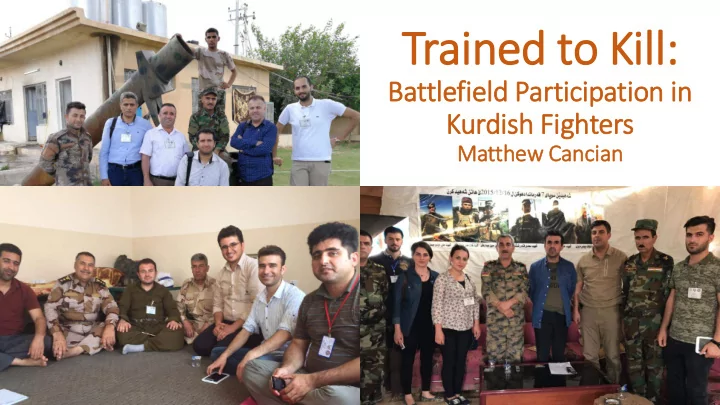

Train ined to Kil ill: Battlefield Part rticipation in in Kurdish Fig ighters Matthew Cancia ian
Can US training improve the battlefield participation of our partners?
Combat motivation: the reasons why soldiers under fire believe that they should continue fighting Combat Battlefield Combat Motivation Participation Effectiveness
Battlefield participation: attempting to defeat the enemy when under fire (vis non-participation by either fleeing or hiding) Combat Battlefield Combat Motivation Participation Effectiveness
Combat effectiveness: the “pound for pound” contribution of each soldier towards achieving victory under enemy fire Combat Battlefield Combat Motivation Participation Effectiveness
Colonel Trevor Dupuy “German divisions were 20 percent more effective than US divisions… Nine of the top 10 divisions in World War II were German."
Cohesion Combat Motivation
How does the experience of combat feed back into battlefield participation? Combat Battlefield Combat Motivation Participation Effectiveness
Modern System Tactics Combat Battlefield Combat Motivation Participation Effectiveness
“A tightly interrelated complex of cover, concealment, dispersion, Modern- suppression, small-unit independent System Tactics maneuver, and combined arms” - Biddle 2006
Cover and Concealment
Dis ispersion
Suppression
Modern US Training System Tactics Combat Battlefield Combat Motivation Participation Effectiveness
2014 – 2017: Untrained Volunteers, Internally Trained Regulars, and 2014 – 2017: Untrained Volunteers, Western Modern-System Internally Trained Regulars, and Western Modern-System Training Training
“Today the Barw rwari Bala trib ibe showed up in in our thousands… to show them that we are here and that they will never take Kurdistan.”
This is not helpful
Mosul Sinjar Erbil Kirkuk Halabja
Untrained Internal Coalition 32.9% 31.2% 35.8%
Hypothesis 1: Calculations of success will be marginally increased by internal training but dramatically increased by coalition training
On a scale of zero to ten, how confident are you in your unit’s readiness for combat?
Untrained Internal Coalition
Untrained Internal Coalition
Untrained Internal Coalition
Regress Training on Confidence Regress Training on Confidence No Clustering Clustering on Bases Internal Coalition Internal Coalition
Hypothesis 2: Coalition training will have a greater positive effect on battlefield participation than internal training
Untrained Internal Coalition
Untrained Internal Coalition Non- Modern Modern System System
Non- Modern Modern System System
Non- Modern 2,283 Peshmerga Modern System System
Cutting Out Non-Combatants Reduces the Sample to 1,739 Non- Modern 1,739 Peshmerga Modern System System
Cutting Out Non-Riflemen Reduces the Sample to 955 Non- Modern 955 Peshmerga Modern System System
I’ll read a number of statements. Don’t tell me which ones you agree with, just tell me how many. In combat:
I’ll read a number of statements. Don’t tell me which ones you agree with, • There was a lot of noise just tell me how many. In combat: • The situation was confusing Control Group + • I didn’t fire back but just Sensitive Group waited for it to be over
Control Group Sensitive Group Non- Non- Modern Modern Modern Modern System System System System
Control Group Sensitive Group Non- Modern Modern System System
Control Group Sensitive Group Non- Modern Modern System System
Control Group + + ? ? = = Sensitive Group Non- Modern Modern System System
Control Group .028 .169* Sensitive Group Non- Modern Modern System System *: p<.01
Traditional Argument: “The source of combat motivation is key – we just need to know what motivates people and we will know both their battlefield participation”
Modern US Training System Tactics Combat Battlefield Combat Motivation Participation Effectiveness
Counter argument #1: “Training is just changing the source of combat motivation – driving people from ideology to group solidarity or faith in their training”
Counter argument #2: “Coalition training is pumping up soldiers to kill, not making them more effective”
Counter argument #3: “Coalition training is just proxying for improved equipment or fire support”
Recommend
More recommend